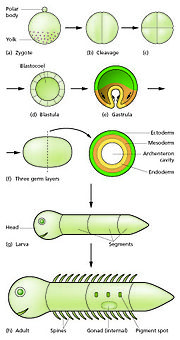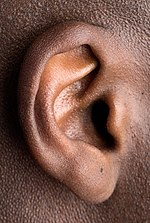Search results
Appearance
The page "Vertebrate development" does not exist. You can create a draft and submit it for review or request that a redirect be created, but consider checking the search results below to see whether the topic is already covered.
- Vertebrates (/ˈvɜːrtəbrɪts, -ˌbreɪts/) are deuterostomal animals with bony or cartilaginous axial endoskeleton — known as the vertebral column, spine...78 KB (7,094 words) - 19:34, 7 October 2024
- Organogenesis (redirect from Organ development)is the development of the notochord, which induces the formation of the neural plate, and ultimately the neural tube in vertebrate development. The development...7 KB (792 words) - 18:30, 21 August 2024
- Cell polarity (section Vertebrate development)relocation is mediated by actin-driven vesicle delivery. The bodies of vertebrate animals are asymmetric along three axes: anterior-posterior (head to tail)...20 KB (2,558 words) - 22:09, 23 September 2024
- Developmental biology (redirect from Biological development)exquisite model for hormonal regulation of postembryonic development in vertebrates". Development, Growth and Differentiation. 38 (3): 223–231. doi:10.1046/j...38 KB (4,421 words) - 04:48, 8 July 2024
- Sonic hedgehog protein (section Tooth development)to development. The sonic hedgehog (SHH) signaling molecule assumes various roles in patterning the central nervous system (CNS) during vertebrate development...62 KB (7,249 words) - 20:50, 23 September 2024
- transiently between the epidermal ectoderm and neural plate during vertebrate development. The neural crest cells originate from this structure through the...41 KB (4,602 words) - 10:39, 23 September 2024
- similar forms of asymmetric, twisted development.[citation needed] Even the most distant clades of vertebrates — the agnathan lampreys and hagfish —...42 KB (4,556 words) - 21:34, 26 August 2024
- Agnatha (redirect from Jawless vertebrates)γνάθος (gnáthos) 'jaws') is a paraphyletic infraphylum of non-gnathostome vertebrates, or jawless fish, in the phylum Chordata, subphylum Vertebrata, consisting...42 KB (2,716 words) - 14:48, 7 October 2024
- motor processing, and underlie behavior. During early embryonic development of the vertebrate, the dorsal ectoderm becomes specified to give rise to the epidermis...52 KB (6,302 words) - 20:50, 23 September 2024
- Limb development in vertebrates is an area of active research in both developmental and evolutionary biology, with much of the latter work focused on the...36 KB (4,235 words) - 19:08, 24 June 2024
- Gnathostomata (redirect from Jawed vertebrate)other vertebrate group. The Osteostraci (bony armored jawless fish) are generally considered the sister taxon of Gnathostomata. Jaw development in vertebrates...29 KB (2,021 words) - 02:52, 26 August 2024
- Pelegri, Francisco; Danilchik, Michael; Sutherland, Ann (2016-12-13). Vertebrate development : maternal to zygotic control. Cham, Switzerland. ISBN 9783319460956...6 KB (641 words) - 04:47, 9 October 2024
- (2000). Developmental Biology. 6th edition. Chapter 11. The early development of vertebrates: Fish, birds, and mammals. Retrieved 3 October 2020. Gilbert,...28 KB (3,187 words) - 20:33, 22 September 2024
- critical group of cells that form in the cranial region during early vertebrate development. Ectomesenchyme plays a critical role in the formation of the hard...1 KB (123 words) - 19:12, 26 August 2024
- Blastulation (section Development)gastrula in which the germ layers of the embryo form. A common feature of a vertebrate blastula is that it consists of a layer of blastomeres, known as the blastoderm...15 KB (1,766 words) - 15:49, 12 July 2024
- Amniote (redirect from Higher vertebrate)vertebrate animals belonging to the clade Amniota, a large group that comprises the vast majority of living terrestrial and semiaquatic vertebrates....48 KB (3,794 words) - 19:35, 7 October 2024
- Brain (redirect from Vertebrate brain)brain is an organ that serves as the center of the nervous system in all vertebrate and most invertebrate animals. It consists of nervous tissue and is typically...132 KB (15,615 words) - 22:56, 13 October 2024
- Ear (redirect from Ear (vertebrate))migrates to the auricle (the visible portion of the ear). The ears of vertebrates are placed somewhat symmetrically on either side of the head, an arrangement...60 KB (6,966 words) - 17:51, 3 October 2024
- The kidneys are a pair of organs of the excretory system in vertebrates, which maintain the balance of water and electrolytes in the body (osmoregulation)...48 KB (5,376 words) - 16:39, 22 May 2024
- colonization allowed for the development of appropriate terrestrial ecosystems that would be available to accommodate vertebrate habitation. While the late...15 KB (1,973 words) - 09:49, 21 September 2024
- 1881 (1881) Man and the Vertebrate Series by Charles Morris 625585Popular Science Monthly Volume 18 April 1881 — Man and the Vertebrate Series1881Charles Morris
- arthropods and vertebrates do not share the same anatomical plan at all, but rather represent two separate evolutionary developments of similar complexity
- Synaptic rearrangement during development characterizes the vertebrate nervous system and was thought to distinguish vertebrates from the invertebrates. However













